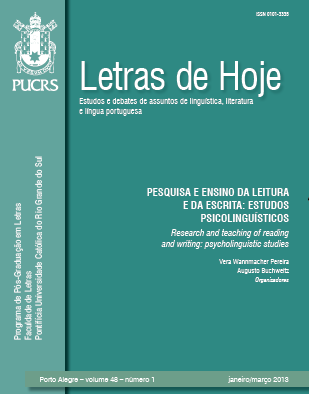Research methods in psycholinguistics: developing a tool for the automatic generation of pseudo-verbs
Keywords:
Pseudo-words, Pseudo-verbs, Data mining, Computational toolAbstract
The use of pseudo-words has benefitted psycholinguistic studies dedicated to the different aspects of the acquisition and processing of language, including reading and writing. However, in most of the studies that make use of pseudowords, the combination of graphemes in a string is often based on the intuition of researchers, who generally do not take the frequency of structural occurrences of the language into consideration. The present study aims at contributing to the development of procedures to aid research which makes use of pseudowords. In this paper, we present a computational tool developed for the generation of pseudoverbs. The process of development of this tool involved the analysis of the structural patterns of the 500 most frequent verbs in Brazilian Portuguese. This analysis was carried out with the use of NLP techniques and data mining in order to collect and extract patterns. The present study adopted an unsupervised machine learning approach since it used an algorithm of clustering for the automatic generation of pseudo-verbs.Downloads
Downloads
How to Cite
Issue
Section
License
Copyright
The submission of originals to Letras de Hoje implies the transfer by the authors of the right for publication. Authors retain copyright and grant the journal right of first publication. If the authors wish to include the same data into another publication, they must cite Letras de Hoje as the site of original publication.
Creative Commons License
Except where otherwise specified, material published in this journal is licensed under a Creative Commons Attribution 4.0 International license, which allows unrestricted use, distribution and reproduction in any medium, provided the original publication is correctly cited.






